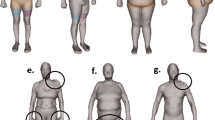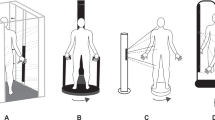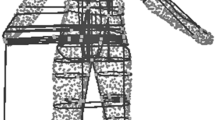Abstract
Anthropometry, Greek for human measurement, is a tool widely used across many scientific disciplines. Clinical nutrition applications include phenotyping subjects across the lifespan for assessing growth, body composition, response to treatments, and predicting health risks. The simple anthropometric tools such as flexible measuring tapes and calipers are now being supplanted by rapidly developing digital technology devices. These systems take many forms, but excitement today surrounds the introduction of relatively low cost three-dimensional optical imaging methods that can be used in research, clinical, and even home settings. This review examines this transformative technology, providing an overview of device operational details, early validation studies, and potential applications. Digital anthropometry is rapidly transforming dormant and static areas of clinical nutrition science with many new applications and research opportunities.
This is a preview of subscription content, access via your institution
Access options
Subscribe to this journal
Receive 12 print issues and online access
$259.00 per year
only $21.58 per issue
Buy this article
- Purchase on Springer Link
- Instant access to full article PDF
Prices may be subject to local taxes which are calculated during checkout



Similar content being viewed by others
References
West GM. Loughborough anthropometric shadow scanner (LASS). Leicestershire, UK: Master of Philosophy, Loughborough University; 1987.
Jones PR, West GM, Harris DH, Read JB. The Loughborough anthropometric shadow scanner (LASS). Endeavour. 1989;13:162–8.
Jones PRM, Rioux M. Three-dimensional surface anthropometry: Applications to the human body. Opt Laser Eng. 1997;28:89–117.
Lerch T, MacGillivray M, Domina T. 3D LaserScanning: A model of multidisciplinary research. J Text Appar, Technol Manag. 2007;5:1–22.
Scharstein D, Szeliski R. High-accuracy stereo depth maps using structured light. 2003 IEEE Comput Soc Conf Comput Vision Pattern Recognit. 2003;1:195–202.
Zhang ZY. Microsoft kinect sensor and its effect. IEEE Multimed. 2012;19:4–10.
Cui Y, Schuon S, Chan D, Thrun S, Theobalt C. 3D shape scanning with a time-of-flight camera. 2010 IEEE Conference on Computer Vision and Pattern Recognition (CVPR); San Francisco, CA, USA: IEEE, June 2010.
Salvi J, Fernandez S, Pribanic T, Llado X. A state of the art in structured light patterns for surface profilometry. Pattern Recogn. 2010;43:2666–80.
Sarbolandi H, Lefloch D, Kolb A. Kinect range sensing: Structured-light versus time-of-flight kinect. Comput Vis Image Und. 2015;139:1–20.
Horaud R, Hansard M, Evangelidis G, Menier C. An overview of depth cameras and range scanners based on time-of-flight technologies. Mach Vision Appl. 2016;27:1005–20.
Rocchini C, Cignoni P, Montani C, Pingi P, Scopigno R. A low cost 3D scanner based on structured light. Comput Graph Forum. 2001;20:C299.
Li X, Iyengar SS. On computing mapping of 3D objects: A survey. ACM Comput Surv. 2015;47:1–45.
Besl PJ, Mckay ND. A Method for registration of 3-D shapes. IEEE T Pattern Anal. 1992;14:239–56.
Pargas RP, Staples NJ, Davis JS. Automatic measurement extraction for apparel from a three-dimensional body scan. Opt Laser Eng. 1997;28:157–72.
Simmons KP, Istook CL. Body measurement techniques: Comparing 3D body‐scanning and anthropometric methods for apparel applications. J Fash Mark Manag: Int J. 2003;7:306–32.
Paquette S. 3D scanning in apparel design and human engineering. IEEE Comput Graph. 1996;16:11–15.
Allen B, Curless B, Popovic Z. The space of human body shapes: reconstruction and parameterization from range scans. ACM T Graph. 2003;22:587–94.
Loffler-Wirth H, Willscher E, Ahnert P, Wirkner K, Engel C, Loeffler M, et al. Novel anthropometry based on 3D-bodyscans applied to a large population based cohort. PLoS ONE. 2016;11:e0159887.
Kouchi M, Mochimaru M. Errors in landmarking and the evaluation of the accuracy of traditional and 3D anthropometry. Appl Ergon. 2011;42:518–27.
Ng BK, Hinton BJ, Fan B, Kanaya AM, Shepherd JA. Clinical anthropometrics and body composition from 3D whole-body surface scans. Eur J Clin Nutr. 2016;70:1265–70.
Medina-Inojosa J, Somers VK, Ngwa T, Hinshaw L, Lopez-Jimenez F. Reliability of a 3D body scanner for anthropometric measurements of central obesity. Obes Open Access. 2016;2:1–9.
Bourgeois B, Ng BK, Latimer D, Stannard CR, Romeo L, Li X, et al. Clinically applicable optical imaging technology for body size and shape analysis: comparison of systems differing in design. Eur J Clin Nutr. 2017;71:1329–35.
Soileau L, Bautista D, Johnson C, Gao C, Zhang K, Li X, et al. Automated anthropometric phenotyping with novel Kinect-based three-dimensional imaging method: comparison with a reference laser imaging system. Eur J Clin Nutr. 2016;70:475–81.
Milanese C, Giachetti A, Cavedon V, Piscitelli F, Zancanaro C. Digital three-dimensional anthropometry detection of exercise-induced fat mass reduction in obese women. Sport Sci Health. 2015;11:67–71.
Farina GL, Spataro F, De Lorenzo A, Lukaski H. A smartphone application for personal assessments of body composition and phenotyping. Sensors (Basel). 2016;16:1–9.
Pradhan L, Song G, Zhang C, Gower B, Heymsfield SB, Allison DB, et al. Feature extraction from 2D images for body composition analysis. 2015 IEEE International Symposium on Multimedia (ISM). Miami, FL: IEEE; 2015.
Braganca S, Arezes PM, Carvalho M. An overview of the current three-dimensional body scanners for anthropometric data collection. In: Arezes, et al., editors. Occupational safety and hygiene III. Boca Raton, FL, USA: CRC Press; 2015. p. 149–53.
Centers for Disease Control (CDC), National Center for Health Statistics (NCHS). National Health and Nutrition Examination Survey (NHANES): Anthropometry procedures manual. In: US Department of Health and Human Services, CDC, editors. Hyattsville, MD: CDC, 2007. p. 1–102..
Liepa P. Filling holes in meshes. Eurographics/ACM SIGGRAPH Symposium on Geometry Processing (SGP); Aachen, Germany: Eurographics Association, 2003.
Li X, Yin Z, Wei L, Wan SH, Yu W, Li MQ. Symmetry and template guided completion of damaged skulls. Comput Graph-Uk. 2011;35:885–93.
Pauly M, Mitra NJ, Giesen J, Gross MH, Guibas LJ. Example-based 3D scan completion. The Third Eurographics Symposium on Geometry Processing. Vienna, Austria: Eurographics Association, 2005.
Heimann T, Meinzer HP. Statistical shape models for 3D medical image segmentation: A review. Med Image Anal. 2009;13:543–63.
Heymsfield SB, Stevens J. Anthropometry: continued refinements and new developments of an ancient method. Am J Clin Nutr. 2017;105:1–2.
Loeffler-Wirth H, Vogel M, Kirsten T, Glock F, Poulain T, Korner A, et al. Body typing of children and adolescents using 3D-body scanning. PLoS ONE. 2017;12:e0186881.
[TC]2 Labs. SizeUSA: The National Sizing Survey. Apex, NC: [TC]2 Labs; Available from: https://www.tc2.com/size-usa.html.
SAE International. Civilian American and European Surface Anthropometry Resource Project—CAESAR®. Warrendale, PA: SAE International; 2017. Available from: http://store.sae.org/caesar/
Acknowledgements
We acknowledge the input provided by optical device manufacturers on the operational details of their respective systems.
Author contributions
SBH, BB, BKN, MJS, XL, and JAS drafted the manuscript; SBH and JAS provided necessary logistical support; SBH, BB, BKN, MJS, XL, and JAS edited the manuscript for intellectual content and provided critical comments on the manuscript.
Funding
This work was partially supported by two National Institutes of Health NORC Center Grants P30DK072476, Pennington/Louisiana; and P30DK040561, Harvard; and R01DK109008, Shape UP! Adults.
Author information
Authors and Affiliations
Corresponding author
Ethics declarations
Conflict of interest
The authors declare that they have no conflict of interest.
Rights and permissions
About this article
Cite this article
Heymsfield, S.B., Bourgeois, B., Ng, B.K. et al. Digital anthropometry: a critical review. Eur J Clin Nutr 72, 680–687 (2018). https://doi.org/10.1038/s41430-018-0145-7
Received:
Accepted:
Published:
Issue Date:
DOI: https://doi.org/10.1038/s41430-018-0145-7
This article is cited by
-
Mobile phone applications for 3-dimensional scanning and digital anthropometry: a precision comparison with traditional scanners
European Journal of Clinical Nutrition (2024)
-
Machine learning-based obesity classification considering 3D body scanner measurements
Scientific Reports (2023)
-
Equations for smartphone prediction of adiposity and appendicular lean mass in youth soccer players
Scientific Reports (2023)
-
Development and validation of an accurate smartphone application for measuring waist-to-hip circumference ratio
npj Digital Medicine (2023)
-
Mobile applications for the sport and exercise nutritionist: a narrative review
BMC Sports Science, Medicine and Rehabilitation (2022)



